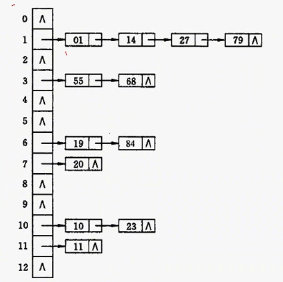c/c++ 哈希表 hashtable 概念:用key去查找value 實現hash函數有很多方法,本文用除留餘數法。 除留餘數法的概念: 取一個固定的基數的餘數,註意不能用偶數,用偶數的話,分佈會不均勻 發生衝突時,用鏈地址法解決 圖形入圖: "完整代碼" ...
c/c++ 哈希表 hashtable
概念:用key去查找value
實現hash函數有很多方法,本文用除留餘數法。
除留餘數法的概念:
取一個固定的基數的餘數,註意不能用偶數,用偶數的話,分佈會不均勻
發生衝突時,用鏈地址法解決
圖形入圖:

#include <stdio.h>
#include <malloc.h>
#include <assert.h>
#include <stdbool.h>
#define ElemType int
#define P 13
typedef struct HashNode{
ElemType data;
struct HashNode* link;
}HashNode;
typedef HashNode* HashTable[P];
void init_hash(HashTable ht){
for(int i = 0; i < P; ++i){
ht[i] = NULL;
}
}
int hash(ElemType key){
return key % P;
}
void insert_hash_table(HashTable ht, ElemType x){
int index = hash(x);
HashNode* s = (HashNode*)malloc(sizeof(HashNode));
assert(s != NULL);
s->data = x;
//頭插
s->link = ht[index];
ht[index] = s;
}
void show_hash_table(HashTable ht){
for(int i = 0; i < P; ++i){
printf("%d: ", i);
HashNode* p = ht[i];
while(NULL != p){
printf("%d->", p->data);
p = p->link;
}
printf("Nul.\n");
}
}
HashNode* search_hash_table(HashTable ht, ElemType x){
int index = hash(x);
HashNode* p = ht[index];
while(NULL != p && p->data != x){
p = p->link;
}
return p;
}
bool remove_hash_node(HashTable ht, ElemType x){
HashNode* p = search_hash_table(ht, x);
if(NULL == p)return false;
int index = hash(x);
HashNode* q = ht[index];
if(p == q){
ht[index] = p->link;
free(p);
return true;
}
while(q->link != p){
q = q->link;
}
q->link = p->link;
free(p);
return true;
}
int main(){
HashTable ht;
init_hash(ht);
ElemType ar[] = {19,14,23,1,68,20,84,27,55,11,10,79};
int n = sizeof(ar) / sizeof(ElemType);
for(int i = 0; i < n; ++i){
insert_hash_table(ht, ar[i]);
}
show_hash_table(ht);
ElemType key = 68;
HashNode* p = search_hash_table(ht, key);
if(NULL != p){
printf("%d\n", p->data);
}
remove_hash_node(ht, key);
show_hash_table(ht);
return 0;
}



